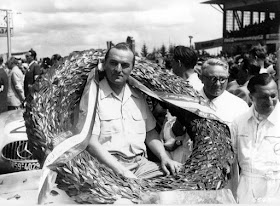 |
| French Grand Prix, July 3, 1938: Triple victory for the Mercedes-Benz W 154 racing cars (Manfred von Brauchitsch – Rudolf Caracciola – Hermann Lang). |
 |
| Tripoli Grand Prix, May 7, 1939. The winner was Hermann Lang in a Mercedes-Benz 1.5 liter W 165 racing car. |
 |
| 1952, Hermann Lang, winner at the Nurburg Ring |
Hermann Lang was born on 6 April 1909 in Cannstatt near Stuttgart. In the 1930s, he is one of the great racing drivers of the Mercedes-Benz Silver Arrows. After the Second World War in 1952, he celebrated a keenly awaited comeback on the Mercedes-Benz 300 SL racing coupé. In 1954, he abandoned professional motor racing, but remained with Mercedes-Benz until retirement as a customer service inspector.
Hermann Lang began his racing career on two wheels and rode an old Norton motorcycle to victory on the Solitude circuit in Stuttgart in 1927 when still an apprentice mechanic. Lang developed into a sidecar specialist as a works rider for motorcycle manufacturer Standard, notching up a series of notable victories during the course of 1931 on his way to the German Hill Climb Championship title for sidecars. In 1933 he was taken on by Daimler-Benz AG as a mechanic in the racing and testing department. Lang was occasionally asked to warm up the brakes for the 750-kilogram-formula cars, which gave him the opportunity to show off his driving talents and secured him a place in a junior drivers’ trial. In 1935 Lang made his first start as a Mercedes-Benz racing driver in the International Eifel Race, going on to finish fifth.
Among his subsequent triumphs were victories in the two fastest races on the global calendar in 1937 – the Tripoli Grand Prix and the Avus race in Berlin. The following season saw Lang further consolidate his position as a leading driver in the
Mercedes-Benz racing team, repeating his success in Tripoli and also taking victory in the Coppa Ciano. Lang, Manfred von Brauchitsch and Rudolf Caracciola formed a trio of Mercedes-Benz Silver Arrows drivers who struck fear into the hearts of their rivals at the time. 1939 saw him reel off successive wins in the Pau and Tripoli Grands Prix, the International Eifel Race and the Höhenstrassenrennen race outside Vienna, setting new track records on each occasion. This outstanding run was backed up by further wins in the Belgian Grand Prix, the German Hill Climb Grand Prix and the Grand Prix of Switzerland, allowing him to secure both the European Championship and Hill Climb Championship that year.
Mercedes-Benz racing team, repeating his success in Tripoli and also taking victory in the Coppa Ciano. Lang, Manfred von Brauchitsch and Rudolf Caracciola formed a trio of Mercedes-Benz Silver Arrows drivers who struck fear into the hearts of their rivals at the time. 1939 saw him reel off successive wins in the Pau and Tripoli Grands Prix, the International Eifel Race and the Höhenstrassenrennen race outside Vienna, setting new track records on each occasion. This outstanding run was backed up by further wins in the Belgian Grand Prix, the German Hill Climb Grand Prix and the Grand Prix of Switzerland, allowing him to secure both the European Championship and Hill Climb Championship that year.
The Second World War failed to stop Lang in his tracks, the German driver picking up where he had left off to fend off all-comers in the first major race of the post-war era – the Ruhestein hill climb in the Black Forest– in his BMW 328 Mille Miglia. He then rejoined the Daimler-Benz AG team following its return to motor racing in 1951 after an absence of twelve years, taking one second and one third place in two races held in Argentina that spring. Lang celebrated a keenly awaited comeback in the 300 SL
(W 194) in 1952, taking second place behind Karl Kling in Bern and teaming up with Fritz Riess to claim overall victory in the Le Mans 24-hour race. Lang called time on his racing career after the Grand Prix of Europe in August 1954, but remained with Mercedes-Benz until retirement as a customer service inspector. He died on
October 19, 1987 in his home district of Bad Cannstatt in Stuttgart.
(W 194) in 1952, taking second place behind Karl Kling in Bern and teaming up with Fritz Riess to claim overall victory in the Le Mans 24-hour race. Lang called time on his racing career after the Grand Prix of Europe in August 1954, but remained with Mercedes-Benz until retirement as a customer service inspector. He died on
October 19, 1987 in his home district of Bad Cannstatt in Stuttgart.

A debt of gratitude is in order for sharing such an extraordinary information........
ReplyDeletesheet metal fabrication
"1939 saw him reel off successive wins in the Pau and Tripoli Grands Prix, the International Eifel Race and the Höhenstrassenrennen race outside Vienna, setting new track records on each occasion. This outstanding run was backed up by further wins in the Belgian Grand Prix, the German Hill Climb Grand Prix and the Grand Prix of Switzerland, allowing him to secure both the European Championship and Hill Climb Championship that year."
ReplyDeleteAs noted in the Caracciola thread comment, H.P. Müller was the 1939 European champion; however deserving Lang might have that season, thanks to points system in place, it was H.P. Müller whose score was the best. This is one of those continuing controversies that seems to defy the application of diligent research and analysis conducted in a scholarly matter when it comes up against legend...
Sometime few educational blogs become very helpful while getting relevant and new information related to your targeted area. As I found this blog and appreciate the information delivered to my database.
ReplyDeleteรถ มือ สอง บาง แสน